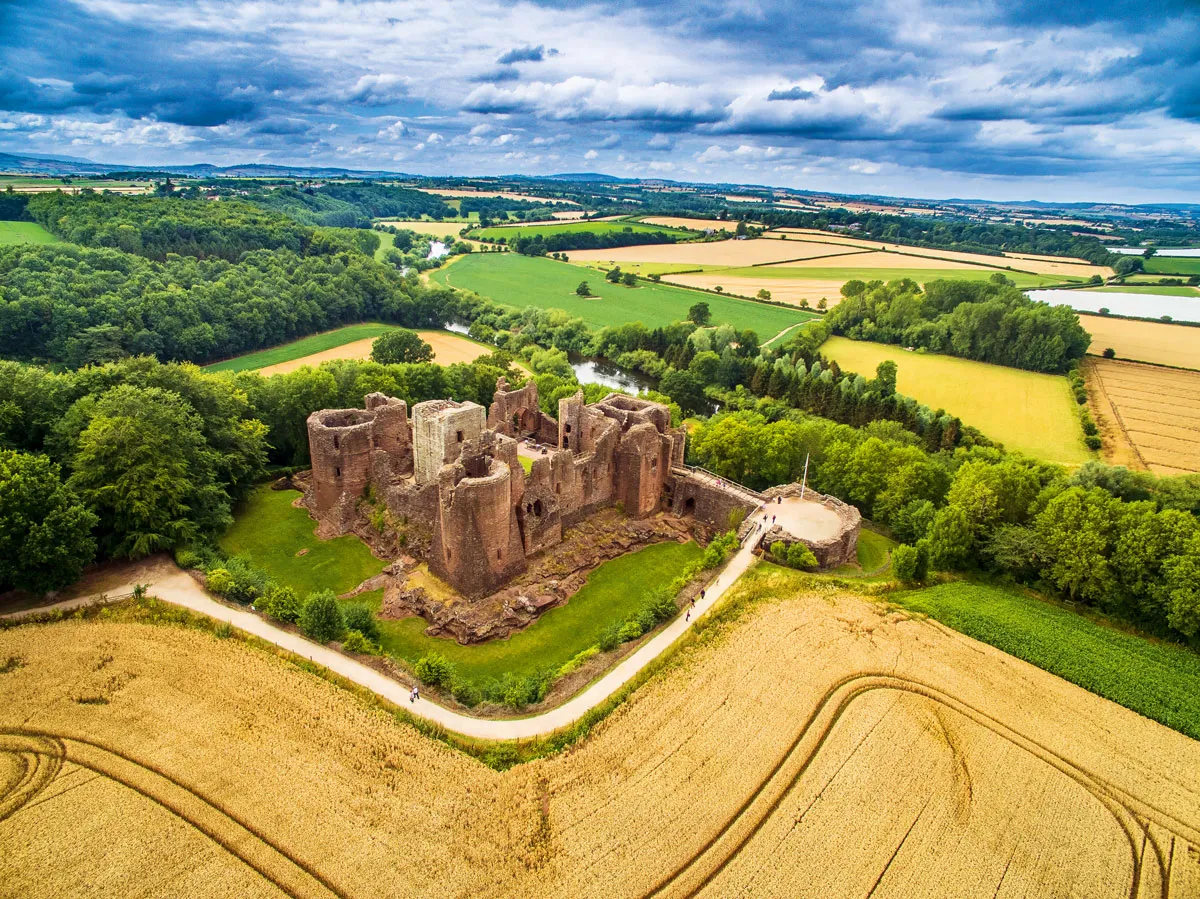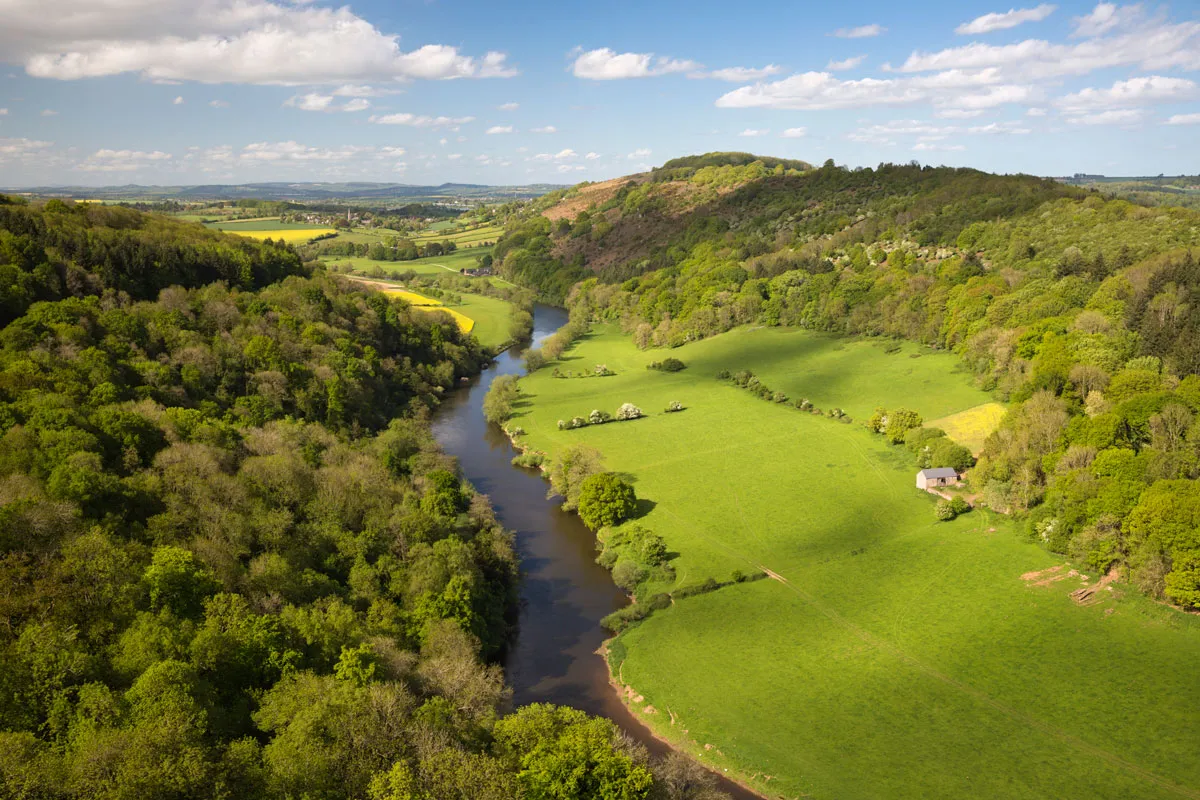I came over the border from Wales just as the sun was setting, like the sheep-rustlers of old. There was no-one about. There never is. The hills were as empty as green sea, and as oxygenated. On the winding back lane from Hay through Michaelchurch Escley, the forbidding wall of the Black Mountains, the highest point in the southern half of England, loomed over me. It looked like Mordor.
Up a foothill, down a foothill, past hedged fields (paddocks really) unchanged since medieval times.
This remote west of Herefordshire is bandit country. For millennia men fortified this choppy edge of England, against wildness, against the Welsh. The Romans tried little stone forts, Offa built a dyke. The Normans studded the landscape with motte-and-baileys. Everywhere you look, even in gardens, there’s a menacing tump. The village of Longtown has a particularly intact stone-cold specimen of Norman military might.
The irony. Today the borderland is as peaceful as England gets. The only noise through the open driver’s window was the soft caw of sheep and the spectral wail of a curlew over Bacton. On the breeze was that hint of woodsmoke, peculiar to high country, whether spring, summer, autumn or winter.
Return to red earth
It was good to be back. I’d only been away for a day. Then the sun, seeing I was a homeboy, did its special local trick, illuminating a freshly ploughed field in the far eastern distance. Red light on red earth, so there seemed no join between earth and sky. County signs indicating ‘Herefordshire’ are superfluous. See the Old Red Sandstone clay soil, you know you are there. This ancient geology also divulged the stone for Hereford’s Gothic cathedral, which houses the Mappa Mundi, a map of the world drawn in the 1300s by a monk with a forgivable parochialism. Hereford is one of the handful of places he deemed mentioning outside the Holy Land. Well, it is heaven on earth.
Heavens, plural, actually. Herefordshire is two landscapes. The upland wild and wet western border, then the pastoral main, a gently rumpled quilt of meadows and arable fields, with the blue haze of trees on swelling hillettes, shadowed lanes of cow parsley, orchards and hopyards. There’s a distinct dividing line between the Herefordshires and you can actually see and sense it as you drive down Cwm Hill into the Golden Valley (the name says it all). On its good grassland, cattle graze, including the famous Herefords. There are orchards, too. Beef and cider: Herefordshire’s two contributions to cuisine.
West or east, this is quiet agricultural country. With a population density of 82 per square kilometre, Herefordshire is among England’s most sparsely populated counties. Not a skyscraper blots the view, and only the bottom end of the shire is touched by a motorway. The direct train from London is single track.
Herefordshire heaven

Driving home this evening, dusk settling like sand in water, the first stars are pristine white atoms. In Herefordshire you can see the heavens above.
Since Herefordshire is on the road and rail track to nowhere, no one much comes or goes. Money has been tight since the Middle Ages, when the fleeces of the county’s Ryeland sheep were worth their weight in gold. North of the city of Hereford, there is a necklace of idyllic black-and-white Tudor villages – Eardisland, Eardisley, Pembridge, Weobley. Chocolate-box lids are ardent for pictures of them. In truth, the villages were conserved by poverty, because no one had the largesse to modernise them. Incomers, though, might attribute the lack of ‘Kirstie Allsopp’ upgrading to what is known as ‘Herefordshire time’, a variant of the Mexican ‘manyana’.
George Orwell thought one of the defining images of England was an old maid cycling through mist to church. I’ll suggest another: three ladies of a certain age playing crib in the backroom of a country pub. Find them at The Crown, up in the Woolhope woods, just seven miles south of Hereford city.
The Crown is slap bang next door to the village church, St George’s, with its timbered ‘Skallenge’ (lych gate), dating from 1581. Almost everywhere you turn, Herefordshire has jewel of a church. It is rich in churches. Woolhope is in the Wye Valley Area of Outstanding Natural Beauty, and if you follow the languid salmony river downstream to Ross, the church gems come thick and intoxicating. Hoarwithy has an Italianate folly. Brockhampton is Arts and Crafts. Yatton, tiny and romantic with an earth floor, is situated in a farmyard of all places. Saint Mary’s at Foy has a rare decagonal font, plus blessed views across the slow, deep green valley.
Wonderful Wye
My family have lived in Herefordshire for 800 years, so we do know the place a bit. I’ll vouchsafe that the stretch of the Wye Valley downstream from the Woolhope Dome is as bucolically beguiling as anywhere, especially if you take the secret riverside lane through Hole-in-the Wall to the market town of Ross-on-Wye. From a distance, Ross seems pinned to its red cliff above the water meadows by the needle steeple of St Mary’s.

The Wye also provides the county’s one famous tourist spot. As early as 1782, when the Reverend William Gilpin published his guidebook Observations on the River Wye, the limestone gorge of Symond’s Yat was a ‘must go’ destination. A century later, eight boats plied ‘The Wye Tour’ river cruise. These days, you can sail the river under you own power, in a canoe. Unlike most rivers, the Wye has a right of navigation.
On the bluffs above the Yat, there are Paleolithic caves and a hillfort at Little Doward, where legend says King Vortigern of the Britons was besieged and slaughtered in AD 458. Violent screams still skirl the cliffs – peregrines have bred in the area since the 1950s.
Nowhere, not even Herefordshire, is unsullied by the spread of agribusiness. Sometimes the flash of silver seen from the brow turns out to be a polytunnel, not a pond. There are silent fields. Hop kilns, the spired buildings where the plant is dried, are as often as not converted into chi-chi abodes.
But hop growing in Herefordshire is holding up. In the fertile valleys of the Frome and the Lugg, hops have been grown since 1577, and probably earlier. The ‘hopyard’, or hop garden, with its towering hedges and trellis of poles and wires, is as quintessentially Herefordian as brown-and-white cows under oaks on a summer’s evening, and Redstrake cider apples hanging like rosy orbs on a misty autumn morning.
Hops have a drowsy perfume. A sleepy herb, then, for a sleepy shire. Ledbury and Bromyard are the market towns of hopland. Bromyard has an annual hop festival. Ledbury is Herefordshire’s poster town, complete with a Jacobean black and white Market House with chestnut pillars.
John Abel, the king’s carpenter, did the woodwork. Church Lane, a tiny cobbled medieval street, leads to St Michaels, with its soaring detached 200ft high spire.
Ledbury is also the county Poet’s Corner. John Masefield, Elizabeth Barrett Browning and William Langland, who scribed the medieval classic, The Vision of Piers Plowman, were all local. In the beginning of the 20th century, the Dymock Poets formed a sort of commune in the neighbourhood. Edward ‘Adlestrop’ Thomas and American Robert Frost were luminaries. The Dymock Poets had a love of nature worthy of the Romantics. Sometimes I park near Little Iddens, the cottage where Frost lived and Thomas was his house guest, and walk along the lanes, following what is now the Poet’s Circle Walk. I do this as a sort of pilgrimage to Thomas because he sacrificed his life for the Herefordshire countryside. He died as Lieutenant Edward Thomas, Royal Garrison Artillery, at Arras in 1917.
Walking with Frost around Dymock, Much Marcle and May Hill, Thomas became besotted with the rustic shire where “the land was sweet”. For Thomas, Herefordshire was “This England”, and his love for it imposed a duty of protection. He fought for King and Countryside. Thomas called Herefordshire “narrow country”. He was right. Oh, there are grand vistas, but what are distinctive are the rolling valley and the little lane, where beauty is immediate, up close: the haze of bluebells in woods; mistletoe hanging in an orchard of gnarled apple trees out by Tenbury Wells; the old stone bridge over the brook; a necklace of bryony, Tic Tac green and orange, draped along the September hedge.
Thomas’ boon companion, Robert Frost wrote his celebrated poem The Road Not Taken about his walks with Thomas in Herefordshire. There’s a phrase in the poem that will do for Herefordshire’s motto. The county is the place “less travelled”. Around the corner of a Herefordshire lane you can still find England as you imagine it.
John Lewis-Stempel is the author of the Sunday Times bestseller The Running Hare and of Meadowland, which won the 2015 Thwaites Wainwright Prize for Nature Writing.
Main image: Alamy
